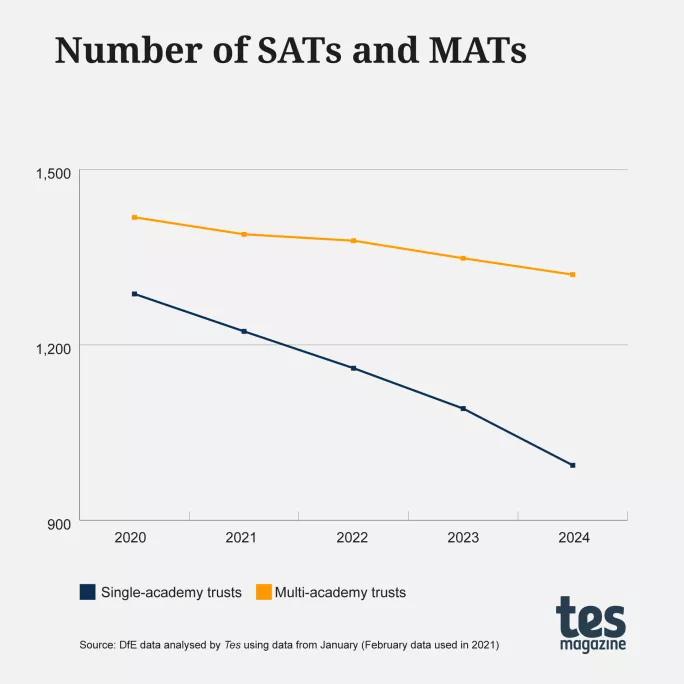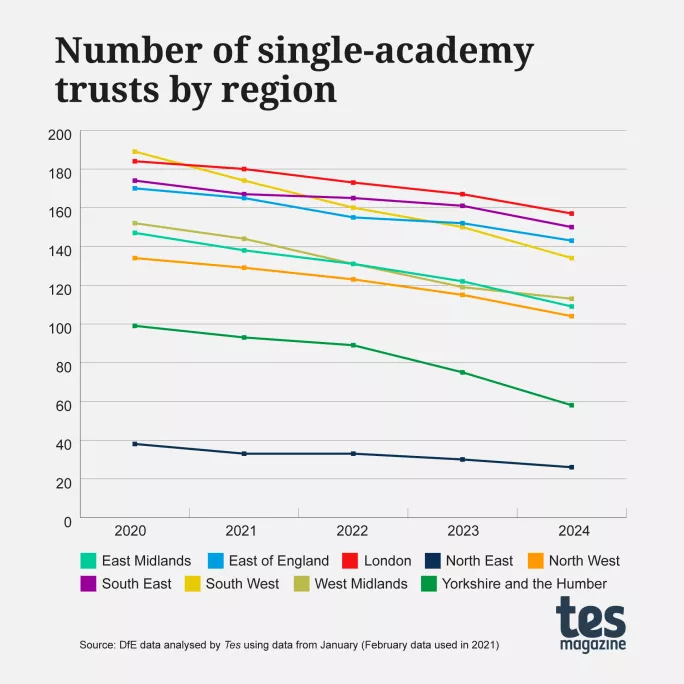- Home
- Leadership
- Data
- What is the outlook for single-academy trusts?
What is the outlook for single-academy trusts?

There has been an increasing movement of schools and single-academy trusts (SATs) into multi-academy trusts (MATs) in recent years - both voluntary and forced.
While the government’s 2030 target for all schools to join “families of schools” has been abandoned, along with the ill-fated Schools Bill, there are still many within the Department for Education who want to see the system move in that direction.
For example, Tes revealed last year how DfE regional teams had identified a widespread need for single or smaller academy trusts to merge or join larger MATs.
However, there are still a large number of SATs across all nine regions in England.
So, where are they concentrated, how many are joining MATs and which types of SATs are disappearing the fastest? Tes has crunched the numbers to find out - here are the main findings…
Sharper decline in single-academy trusts
While the overall number of academy trusts has been decreasing steadily over the past four years, by 1 or 2 per cent year-on-year, SATs are falling at a much faster rate - and this is becoming more pronounced.
Between 2020 and 2021, the number of SATs fell by 5 per cent.
There was a slightly larger decline of 6 per cent between 2022 and 2023, taking the number of SATs down from 1,160 to 1,091.
This decline then accelerated in the year to January 2024, with the number of SATs falling by almost 9 per cent, from 1,091 to 994.
Jenna Julius, research director at the National Foundation for Educational Research, said the “rate of movements into and between MATs slowed” both during and immediately after Covid “when schools were focused on grappling with the impact of the pandemic”.
But the 2022 Schools White Paper encouraged SATs, smaller MATs and local authority-run schools to consider joining or forming larger trusts - “and has almost certainly been a factor in the more recent drop in SAT numbers”, she added.
Mark Blackman, director of education consultancy Leadership Together, said that SATs became “much more outward focused very quickly during the pandemic” and, as a result, “collaboration” was on their agenda when they came out the other side.

Primary SATs seeing a steeper fall
As of January 2024, 398 primary SATs and 497 secondary SATs were open, according to DfE data.
There were also 39 special SATs, 10 middle deemed secondary SATs, 17 alternative provision SATs, 21 all-through SATs and 12 16-plus SATs.
Last term, regional boards approved 37 SATs to join MATs, according to a Tes analysis of board minutes carried out as part of our newly launched MAT Tracker. They also approved the creation of 16 new MATs across the country.
The number of both primary and secondary SATs in England has fallen by 23 per cent in the four years since January 2020.

However, while the speed of decline for secondary SATs has remained steady over that time period, primary SATs have fallen at a much steeper rate since 2022.
Between 2020 and 2022, the number of secondary SATs fell by 12 per cent to 569, while primary SATs fell by 7 per cent to 480.
In the following two years, the number of primary SATs fell by 17 per cent from 480 to 398, while secondary SATs fell by 13 per cent, from 569 to 497.

The steeper fall could be down to financial pressures. Primary SATs, in particular, are seeing in-year deficits for the second consecutive year, while large MATs are “faring better financially”, according to a recent report.
Ms Julius said that there is no conclusive evidence on the reasons for the faster decline of primary SATs in recent years, but one explanation could be “current and projected declines in primary pupil numbers...and the financial pressures which falling pupil roles present”.
Last year, government data revealed that the number of primary pupils in state-funded schools was projected to fall by more than 410,000 over the next five years.
Mr Blackman said the last few years had been “a particularly challenging period of time” for small schools and SATs.
There is a large ask of SATs “in terms of the compliance functions and the reporting functions that they have to do”, he said.
‘Natural movement’ towards MATs
For primary schools, in particular, he said: “There’s been a growing realisation that the breadth of curriculum and the demands to get that right mean that collaboration has become very, very normal in the primary school space.
“So I think it’s about natural movement and natural affiliation...equally driven by a challenging financial picture.”
Dean Lythgoe is headteacher of St Aidan’s Church of England Academy, an SAT in Darlington that was recently approved to join a MAT by the North East advisory board.
He told Tes: “There is a sense of the mode mission in the country and the sense of a push towards MATs, coupled with the fact that SATs are no longer being seen as a means to effectively run a school.”
Mr Lythgoe said that there is a “tide” that is “going in that direction”.
However, he also said that he feels there is a “value in partnering with like-minded schools and the ability to benefit from working together” and that it “can be lonely for one-person departments in small schools”.
Special school SATs, meanwhile, fell by 6 per cent between 2020 and 2023 - from 48 to 45 trusts - although recent data indicates a possible change in pace.
Between January 2023 and 2024, the number of special school SATs fell from 45 to 39, a fall of 13 per cent.
Where are single-academy trusts concentrated?
The highest number of SATs as of January 2024 can be found in Hertfordshire. Its 45 SATs constitute more than half (58 per cent) of all trusts covered by the local authority.
Meanwhile, Kent had 37 (59 per cent of all trusts) and Lincolnshire recorded 35 - slightly more than its number of MATs (34).
Gloucestershire, Essex and Leicestershire all had 34 SATs, while Buckinghamshire had 30.
Gloucestershire has twice as many SATs as MATs (34 compared with 17), while in Leicestershire, the number of SATs and MATs are largely equal.
In 14 local authorities, there are no SATs at all, and 17 areas have just one.
Regional spread of SATs
London had the most SATs out of the nine regions as of January 2024, with 157 recorded.
However, under a third (30 per cent) of London’s trusts are SATs, compared with 38 per cent in the South West, where the number of SATs has fallen by 29 per cent since 2020.
The North East had the fewest SATs (26) and has seen a 32 per cent drop in SAT numbers since 2020 - the biggest drop across any region. Just 13 per cent of trusts in the North East are SATs - the smallest proportion in the country.
Asked why the picture is patchy across the country, Mr Blackman said he thought it was a “picture of how quickly various areas engaged with academisation”.
“Those that were early to academisation through the conversion process will have had more SATs because that was largely the only model on offer,” he said.
Those that came later were encouraged to join groups of schools or to form groups of schools together, he added.
Ms Julius said that the regional variation “mirrors wider differences in the extent of academisation across regions”, reflecting the way the current school system has “organically evolved over the last two decades”.

What does the future hold?
The government’s previous plan for all schools to be in MATs or “families of schools” by 2030 sparked backlash from those who felt the timescale was too “rapid” and could affect the quality of MATs.
The Schools Bill was ultimately scrapped in December 2022 and the government’s approach to academisation now appears ambiguous.
However, our analysis shows how SATs are still declining in number, and that this decline is accelerating for primaries - probably driven by tight finances.
Mr Blackman said: “I think if the financial picture stays as challenging as it is for schools, then more SATs will join MATs. Grouping your funding together makes sense to achieve all sorts of economies of scale, but also to support each other in what is a very difficult climate for schools in any case.
He added: “Recruitment and retention are both real challenges, and I think some of the MATs have got answers to those that a single school or a single-academy trust doesn’t.”
No strong policy on SATs
At a political level, a significant shift in emphasis looks unlikely. Should Labour win this year’s general election, as is widely predicted, it has made clear that it is not looking to introduce any wholesale structural reform.
This is despite the school system being “fragmented, opaque and over-complex”, according to shadow education secretary Bridget Phillipson.
Speaking last year, she said the difference between local authority-run and academy schools often shapes debate, but “mostly means nothing to parents”.
However, she has also said that she wants “to smooth the differences” of a two-tier school system.
For now, there are no strong policy forces propelling SATs towards certain extinction. But other factors look set to encourage more SAT mergers, moves and dissolutions.
Find our interactive map of England’s multi-academy trusts here, along with links to all of our MAT Tracker content
You need a Tes subscription to read this article
Subscribe now to read this article and get other subscriber-only content:
- Unlimited access to all Tes magazine content
- Exclusive subscriber-only stories
- Award-winning email newsletters
Already a subscriber? Log in
You need a subscription to read this article
Subscribe now to read this article and get other subscriber-only content, including:
- Unlimited access to all Tes magazine content
- Exclusive subscriber-only stories
- Award-winning email newsletters
topics in this article



